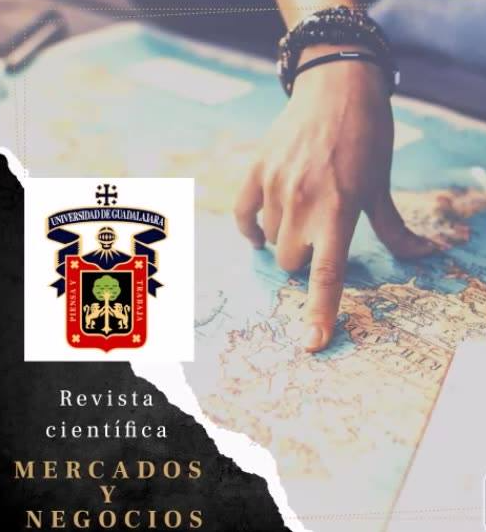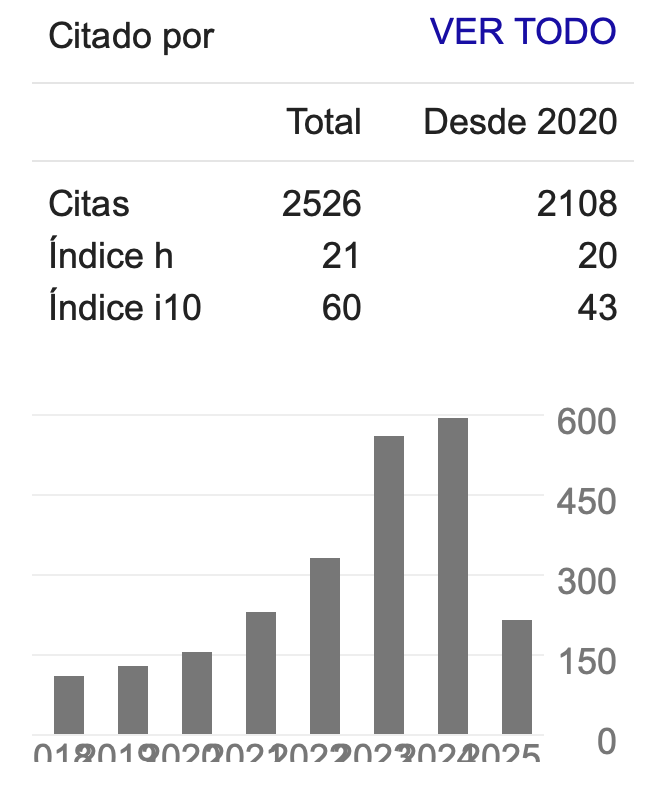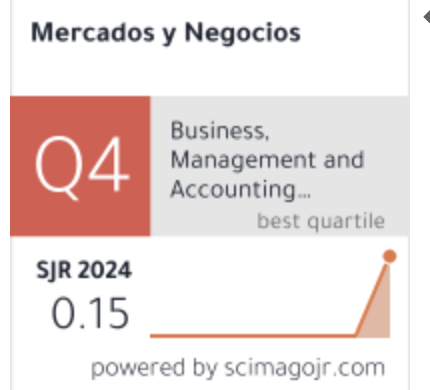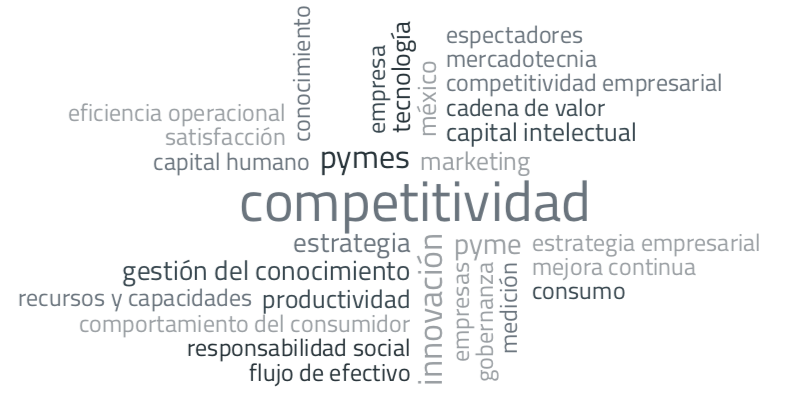Impact of the Supply Chain on Sustainable and Business Performance During the COVID-19 Pandemic
DOI:
https://doi.org/10.32870/myn.vi53.7744Keywords:
Supply chain, COVID-19 pandemic, Sustainable performance, Firm performanceAbstract
The main objective of this empirical study is to provide empirical evidence that allows quantifying the impact of the supply chain on sustainable and firm performance during the COVID-19 pandemic. An electronic survey was applied to collect information on 65 manufacturing firms selected through simple random sampling, using the statistical technique of Partial Least Squares Structural Equation Modeling (PLS-SEM) to analyze the data obtained using the SmartPLS 4.0 software. Furthermore, the analysis carried out in this study identifies a need for more theoretical and, above all, empirical evidence in this area, which prevents the generalization of the results obtained. Likewise, the results suggest that during the COVID-19 pandemic, the supply chain positively impacted sustainable performance. However, an adverse effect was also detected on firm performance, so it is possible to conclude that the COVID-10 pandemic substantially improved the sustainable performance of manufacturing companies. However, it also generated a decrease in their level of firm performance.References
Abhishek, B.V., Gupta, P., Kaushik, M., Kishore, A., Kumar, R., Sharma, A., & Verna, S. (2020). India’s food system in the time of COVID-19. Economic & Political Weekly, 55(15), 12–14.
Acar, M.F., Özel-Torgalöz, A., Eryarsoy, E., & Zaim, S. (2022). Did COVID-19 change the rules of the game for supply chain resilience? The effects of learning culture and supplier trust. International Journal of Physical Distribution & Logistics Management, 52(7), 491-511. https://doi.org/10.1108/IJPDLM-05-2021-0204
Afshari, H., Searcy, C., & Jaber, M. (2020). The role of eco-innovation drivers in promoting additive manufacturing in supply chains. International Journal of Production Economics, 223(5), 10–38. https://doi.org/10.1016/j.ijpe.2019.107538
Aljuneidi, T., Bhat, A.S., & Boulaksil, Y. (2023). A comprehensive systematic review of the literature of the impact of the COVOD-19 pandemic on supply chains. Supply Chain Analytics, 3(1), 1-23. https://doi.org/10.1016/j.sca.2023.100025.
Bag, S. (2014). Impact of sustainable supply chain management on organizational performance: Mediating effects of leadership. Indian Journal of Management Science, 4(3), 10-25l.
Bagozzi, R., Yi, Y. & Philipps, L. (1991). Assessing construct validity in organizational research. Administrative Science Quarterly, 36(1), 421-458. https://doi.org/10.2307/2393203
Bansal, P. (2005). Evolving sustainably: A longitudinal case study of corporate sustainable development. Strategic Management Journal, 26(3), 197–218. https://doi.org/10.1002/smj.441
Belhadi, A., Kamble, S., Jabbour, C.J., Gunasekaran A., Ndubisi, N.O., & Venkatesh, M. (2020). Manufacturing and service supply chain resilience to the COVID-19 outbreak: Lessons learned from the automobile and airline industries. Technological Forecasting & Social Science, 163(2), 1-12. https://doi.org/10.1016/j.techfore.2020.120447
Belhouideg, S. (2020). Impact of 3D printed medical equipment on the management of the COVID-19 pandemic. International Journal of Health Planning & Management, 25(5), 1014-1032. https://doi.org/10.1002/hpm.3009
Business Insider (2020). Using blue shop towels in homemade face masks can filter particles 2x to 3x better than cotton, three clothing designers discover after testing dozens of fabrics. Business Insider. Link: https://www.businessinsider.com/homemade-mask-using-hydro-knit-shop-towel-filters-better-2020-4
Butt, A.S. (2021). Strategies to mitigate the impact of COVID-19 on supply chain disruptions: A multiple case analysis of buyers and distributors. International Journal of Logistics Management, ahead on print. https://doi.org/10.1108/IJLM-11-2020-0455
Chan, R.Y.C. (2005). Does the natural-resource-based view of the firm apply in an emerging economy? A survey of foreign invested enterprises in China. Journal of Management Studies, 42(3), 625–672. https://doi.org/10.1111/j.1467-6486.2005.00511.x
Chang, S.E., Brown, C., Handmer, J., Helgeson, J., Kajitani, Y., Keating, A., Noy, I., Watson, M., Derakhshan, S., Kim, J., Roa-Heriquez, A. (2022). Business recovery from disasters: Lessons from natural hazards and the COVID-19 pandemic. International Journal of Disaster Risk Reduction, 80(10), 1–12. https://doi.org/10.1016/j.ijdrr.2022.103191
Chervenkova, T., & Ivanov, D. (2023). Adaptation strategies for building supply chain viability: A case study analysis of the global automotive industry repurposing during the COVID-19 pandemic. Transportation Research Part E: Logistics and Transportation Review, 177(9), 1-12. https://doi.org/10.1016/j.tre.2023.103249
Chiaramonti, D., & Maniatis, K. (2020). Security of supply, strategic storage and COVID-19: Which lessons learned for renewable and recycling carbon fuels, and their future role in decarbonizing transport? Applied Energy, 271(8), 1-12. https://doi.org/10.1016/j.apenergy.2020.115216
Chin, W. (2010). How to write up and report PLS analysis. In Esposito, V., Chin, W., Henseler, J. and Wang, H. (Eds.), Handbook of Partial Least Squares: Concepts, Methods and Applications in Marketing and Related Fields. Berlin: Springer, 655-690. https://doi.org/10.1007/978-3-540-32827-8_29
Choi, T.M. (2020). Innovative “bring-service-near-your-home” operations under Corona-Virus (COVID-19/SARS-CoV-2) outbreak: Can logistics become the Messiah? Transportation Research Part E: Logistics and Transportation Review, 140(8), 1–14.
Chowdhury, P., & Paul, S.K. (2020). Applications of MCDM methods in research on corporate sustainability: A systematic literature review. Management of Environmental Quality, 31(2), 385–405. https://doi.org/10.1108/MEQ-12-2019-0284
Chowdhury, P., Kumar, S.P., Kaiser, S., & Moktadir, M.A. (2021). COVID-19 pandemic related supply chain studies: A systematic review. Transportation Research Part E, 148(2), 1–10. https://doi.org/10.1016/j.tre.2021.102271
Deloitte (2020). Consideraciones contables relacionadas con la enfermedad Coronavirus 2019. Deloitte. Link: https://www2.deloitte.com/content/dam/Deloitte/cr/Documents/audit/documentos/IFRS-in Focus--Enfermedad-COVID-19.pdf
Dente, S.M., & Hashimoto, S. (2020). COVID-19: A pandemic with positive and negative outcomes on resource and waste flows and stocks. Resources Conservation and Recycling, 161(10), 1-12. doi: 10.1016/j.resconrec.2020.104979
Dijkstra, T. & Henseler, J. (2015). Consistent partial least squares path modeling. MIS Quarterly, 39(2), 297-231.
Donoth, A., Elayan, R.A., Ronen, J., & Ronen, T. (2020). Unfair “fair value” in illiquid markets: Information spillover effects in times of crisis. Management Science, 67(8), 4643-5300. https://doi.org/10.1287/mnsc.2020.3737
Donthu, N., & Gustafsson, A. (2020). Effects of COVID-19 on business and research. Journal of Business Research, 117(1), 284-289. https://doi.org/10.1016/j.jbusres.2020.06.008
Drolet, A. & Morrison, D. (2001). Do we really need multiple-item measures in service research? Journal of Service Research, 3(1), 196-204. https://doi.org/10.1177/109467050133001
Farias, D., & Araújo, F.F. (2020). Will COVID-19 affect food supply chain in distribution center of Brazilian regions affected by the pandemic? Trends in Food Science & Technology, 103(9), 361-366. https://doi.org/10.1016/j.tifs.2020.05.023
Fornell, C., & Larcker, D. (1981). Evaluating structural equation models with unobservable variables and measurement error. Journal of Marketing Research, 18(1), 39-50. https://doi.org/10.1177/002224378101800104
Fortune, (2020). 94% of the Fortune 1000 are Seeing Coronavirus Supply Chain Disruptions: Report. Fortune. Link: www.fortune.com.
Forza, C. (2016). Surveys. In: C. Karlsson (Ed.), Research Methods for Operations Management. 2nd Ed. New York, NY: Routledge. 37–56.
Gligor, D., Gligor, N., Holcomb, M., & Boskur, S. (2019). Distinguishing between the concepts of supply chain agility and resilience. The International Journal of Logistics Management, 30(2), 467-487. https://doi.org/10.1108/IJLM-10-2017-0259
Goodhue, D., Lewis, W. & Thompson, R. (2012). Does PLS have advantages for small sample size or non-normal data? MIS Quarterly, 36(1), 891–1001. https://doi.org/10.2307/41703490
Guan, D., Wang, D., Hallegatte, S., Davis, S.J., Huo, J., Li, S., Bai, Y., Lei, T., Xue, Q., Coffman, D.M., Chen, P., Liang, X., Xu, B., Wang, S., Hubacek, K., & Gong, P. (2020). Global supply-chain effects of COVID-19 control measures. Nature Human Behavior, 4(3), 577-587.
Guest Editorial (2022). Guest editorial: The “new normal”: Rethinking supply chains during and post-COVID-19 global business environment. International Journal of Physical Distribution & Logistics Management, 52(7), 481-490. https://doi.org/10.1108/IJPDLM-08-2022-518
Gunessee, S., & Subramanian, N. (2020). Ambiguity and its coping mechanisms in supply chains lessons from the COVID-19 pandemic and natural disasters. International Journal of Operations & Production Management, 40(7/8), 1201-1223. https://doi.org/10.1108/IJOPM-07-2019-0530
Hair, J., Hult, T., Ringle, C., Sarstedt, M., Castillo, J., Cepeda, G. & Roldán, J.L. (2019). Manual de Partial Least Squares PLS-SEM. 2nd Edition. Madrid: OmniaScience.
Hair, J., Page, M. & Runsveld, N. (2016). Essentials of Business Research Methods. 4th Ed. New York, NY: Routledge. https://doi.org/10.4324/9780429203374
Hair, J., Ringle, C. & Sarstedt, M. (2011). PLS-SEM: Indeed, a silver bullet. Journal of Marketing Theory and Practice, 19(1), 139-151. https://doi.org/10.2753/MTP1069-6679190202
Hair, J., Sarstedt, M., Pieper, T. & Ringle, C. (2012). The use of partial least squares structural equation modeling in strategic management research: A review of past practices and recommendations for future applications. Long Range Planning, 45(1), 320-340. https://doi.org/10.1016/j.lrp.2012.09.008
Haraguchi, M., Neise, T., She, W., & Taniguchi, M. (2023). Conversion strategy supply chain resilience during the COVOD-19 pandemic: A typology and research directions. Progress in Disaster Science,17(1), 1-7. https://doi.org/10.1016/j.pdisas.2023.100276
Haren, P., & Simchi-Levi, D. (2020). How coronavirus could impact the global supply chain by mid-March. Harvard Business Review, 28(2), 1-12.
Hayduk, L. & Littvay, L. (2012). Should researchers use single indicators, best indicators, or multiple indicators in structural equation models? BMC Medical Research Methodology, 12(159), 1-12. https://doi.org/10.1186/1471-2288-12-159
Hazarika, N., & Xiaoling Zhang, X. (2019). Factors that drive and sustain eco-innovation in the construction industry: the case of Hong Kong. Journal of Cleaner Production, 238(1). 11–16. https://doi.org/10.1016/j.jclepro.2019.117816
Henseler, J., Ringle, C. & Sarstedt, M. (2012). Using partial least squares path modeling in international advertising research: Basic concepts and recent issues. In Okasaki, S. (Ed.), Cheltenham. Handbook of Research in international Advertising. Cheltenham, UK: Edward Elgar. 201-225. https://doi.org/10.4337/9781781001042.00023
Henseler, J., Ringle, C. & Sarstedt, M. (2015). A new criterion for assessing discriminant validity in variance-based structural equation modeling. Journal of the Academy of Marketing Science, 43(1), 115-135. https://doi.org/10.1007/s11747-014-0403-8
Henseler, J., Ringle, C. & Sinkovics, R. (2009). The use of partial least squares path modeling in international marketing. Advances in International Marketing, 20(1), 277-320. https://doi.org/10.1108/S1474-7979(2009)0000020014
Hobbs, J.E. (2020). Food supply chains during the COVID-19 pandemic. Canadian Journal of Agricultural Economics, 68(1), 171–176.https://doi.org/10.1111/cjag.12237
Hu, L.T., & Bentler, P.M. (1998). Fit indices in covariance structure modeling: Sensitivity to under parameterized model misspecification. Psychological Methods, 3(1), 424-453. https://doi.org/10.1037/1082-989X.3.4.424
Ivanov, D. (2020a). Predicting the impacts of epidemic outbreaks on global supply chain: A simulation-based analysis on the coronavirus outbreak (COVID-19/SARS-Cov-2) case. Transportation Research Part E: Logistics Transportation Review, 136(4), 1–12. https://doi.org/10.1016/j.tre.2020.101922
Ivanov, D. (2020b). Viable supply chain model: Integrating agility, resilience and sustainability perspectives: Lessons from and thinking beyond the COVID-19 pandemic. Annals of Operations Research, 319(5), 1411–141. https://doi.org/10.1007/s10479-020-03640-6
Ivanov, D. (2024). Exiting the COVID-19 pandemic: After-sock risks and avoidance of disruption tails in supply chains. Annals of Operations Research, 335(16), 1627–1644. https://doi.org/10.1007/s10479-021-04047-7
Ivanov, D., & Das, A. (2020). Coronavirus (COVID-19/SARS-Cov-2) and supply chain resilience. A research note. International Journal of Integrating Supply Management, 13(1), 90-102. https://doi.org/10.1504/IJISM.2020.107780
Ivanov, D., & Dolgui, A. (2020a). OR-methods for coping with the ripple effect in supply chains during COVID-19 pandemic: managerial insights and research implications. International Journal of Production Economics, 232(2), 1-10. https://doi.org/10.1016/j.ijpe.2020.107921
Ivanov, D., & Dolgui, A. (2020b). Viability of intertwined supply networks: Extending the supply chain resilience angles towards survivability: A position paper motivated by COVID-19 outbreak. International Journal of Production Research, 58(12), 2904-2915. https://doi.org/10.1080/00207543.2020.1750727
Iyengar, K., Bahl, S., Vaishya, R., & Vaish, A. (2020). Challenges and solutions in meeting up the urgent requirement of ventilators for COVID-19 patients. Diabetes Metabolism and Syndrome Clinical Research Review, 14(4), 499-501. https://doi.org/10.1016/j.dsx.2020.04.048
Karamoozian, A., Tan, C.A., Wu, D., Karamoozian, A., & Piras, S.T. (2024). COVID-19 automotive supply chain risks: A manufacturer-supplier development approach. Journal of Industrial Information Integration, 38(3), 1-11. https://doi.org/10.1016/j.jii.2024.100576
Koonin, L.M. (2020). Nivel coronavirus disease (COVID-19) outbreak: Now is the time to refresh pandemic plans. Journal of Business and Continuity & Emergency Planning, 13(4), 298–312.
Kouhizadeh, M., Saberi, S., & Sarkis, J. (2021). Blockchain technology and the sustainable supply chain: Theoretically exploring adoption barriers. International Journal of Production Economics, 231(1), 1-11. https://doi.org/10.1016/j.ijpe.2020.107831
Leite, H., Lindsay, C., & Kumar, M. (2020). COVID-19 outbreak: Implications on healthcare operations. The TQM Journal, 33(1), 247–256. https://doi.org/10.1108/TQM-05-2020-0111
Lin, Z., Wang, S., & Yang, L. (2020). Motivating innovation alliance's environmental performance through eco-innovation investment in a supply chain. Journal of Cleaner Production, 269(1), 12-23. https://doi.org/10.1016/j.jclepro.2020.122361
Lui, Y., Zhu, Q., & Seuring, S. (2020). New technologies in operations and supply chains: Implications for sustainability. International Journal of Production Economics, 229(11), 11-22. https://doi.org/10.1016/j.ijpe.2020.107889
Majumdar, A., Shaw, M., & Sinha, S.K. (2020). COVID-19 debunks the myth of social sustainable supply chain: A case of the clothing industry in South Asian countries. Sustainable Production and Consumption, 24(1), 150-155. https://doi.org/10.1016/j.spc.2020.07.001
Marco-Ferreira, A., Fidelis, R., Hosrt, D.J., & Andrade, P.P. (2023). Mitigating the impacts of COVID-19: Failure mode and effect analysis and supply chain resilience (FMEA-SCR) combined model. Modern Supply Chain Research and Applications, 5(3), 158-175. https://doi.org/10.1108/MSCRA-10-2022-0024
Mariappan, M.B., Devi, K., Venkataraman, Y., & Fosso-Wamba, S. (2022). A large-scale real-world comparative study using pre-COVID lockdown and post-COVID lockdown data on predicting shipment times of therapeutics in e-pharmacy supply chains. International Journal of Physical Distribution & Logistics Management, 52(7), 512-537. https://doi.org/10.1108/IJPDLM-05-2021-0192
Marshall, D., McCarthy, L., Heavey, C., & McGrath, P. (2014). Environmental and social supply chain management sustainability practices: Construct development and measurement. Production Planning & Control, 1(1), 1-18. https://doi.org/10.1080/09537287.2014.963726
Mbah, R.E., & Wasum, D. (2022). Russian-Ukraine 2022 war: A review of the economic impact of the Russian-Ukraine crisis on the USA, UK, Canada, and Europe. Advanced in Social Sciences Research Journal, 9(3), 144-153. http://dx.doi.org/10.14738/assrj.93.12005
McMaster, M., Nettleton, C., Tom, C., Xu, B., Cao, C., & Qiao, P. (2020). Risk management: Rethinking fashion supply chain management for multinational corporations in light of the COVID-19 outbreak. Journal of Risk Financial Management, 13(8), 1–16. https://doi.org/10.3390/jrfm13080173
Mena, C., & Schoenherr, T. (2020). The green contagion effect: an investigation into the propagation of environmental practices across multiple supply chain tiers. International Journal of Production Research, 61(14), 4808-4825. https://doi.org/10.1080/00207543.2020.1834160
Mishrif, A., & Khan, A. (2023). Digitalization policy design and implementation in the logistics and supply chain sector during the time of Covid-19. Journal of International Logistics and Trade, 21(3), 135–158. https://doi.org/10.1108/JILT-10-2022-0053
Nandi, S., Sarkis, J., Hervani, A.A., & Helms, M.M. (2021). Redesigning supply chains using blockchain-enabled circular economy and COVID-19 experiences. Sustainable Production and Consumption, 27(1), 10-22. https://doi.org/10.1016/j.spc.2020.10.019
Naz, F., Kumar, A., Mujamdar, A., & Agrawal, R. (2021). Is artificial intelligence an enabler of supply chain resilience post COVID-19? An exploratory state-of-the-art review for future research. Operational Management Research, 15(1), 378-392. https://doi.org/10.1007/s12063-021-00208-w
Nikookar, E., Yanadori, Y. (2022). Forming post-COVID supply chains: Does supply chain managers’ social network affect resilience? International Journal of Physical Distribution & Logistics Management, 52(7), 538-566. https://doi.org/IJPDLM-05-2021-0167
Nordhagen, S., Igbeka, U., Rowlands, H., Shine, R.S., Heneghan, E., & Tench, J. (2021). COVID-19 and small enterprises in the food supply chain: Early impacts and implications for longer-term food system resilience in low and middle-income countries. World Development, 141(5), 1–14. https://doi.org/10.1016/j.worlddev.2021.105405
Paul, S.K., & Chowdhury, P. (2020). A production recovery plan in manufacturing supply chains for a high-demand item during COVID-19. International Journal of Physical Distribution and Logistics Management, 51(2), 104–125. https://doi.org/10.1108/IJPDLM-04-2020-0127
Queiroz, M.M., Ivanov, D., Dolgui, A., & Fosso-Wamba, S. (2020). Impacts of epidemic outbreaks on supply chains; Mapping a research agenda aim the COVID-19 pandemic through a structure literature review. Annals of Operations Research, 319(11), 1159-1196. https://doi.org/10.1007/s10479-020-03685-7.
Rajak, S., Mathiyazhagan, K., Agarwal, V., Sivakumar, K., & Kumar, V. (2022). Issues and analysis of critical success factors for the sustainable initiatives in the supply chain during the COVID-19 pandemic outbreak in India: A case study. Research in Transportation Economics, 93(1), 1-13. https://doi.org/10.1016/j.retrec.2021.101114
Ranney, M.L., Griffeth, V., & Jha, A.K. (2020). Critical supply shortages. The need for ventilators and personal protective equipment during the Covid-19 pandemic. New England Journal of Medicine, 382(18), 11–21. https://doi.org:10.1056/NEJMp2006141
Renn, O., Laubichler, M., Lucas, K., Kröger, W., Schanze, J., Scholz, R.W., & Schweizer, P.J. (2022). Systematic risks from different perspectives. Risk Analysis, 42(9), 1902-1920. https://doi.org/10.1111/risa.13657
Reza, K.M., Hafezalkotob, A., Asian, S., Makui, A., & Zhang, A.N. (2020). Peer-to-peer financing choice of SME entrepreneurs in the re-emergence of supply chain localization. International Transactions in Operational Research, 27(5), 2534-2558. https://doi.org/10.1111/itor.12715
Reza, K.M., Seif, M., & Hanne, T. (2023). Effects and challenges of the COVID-19 pandemic in supply chain management: A txt analytics approach. Supply Chain Forum: An International Journal, 1-18. https://doi.org/10.1080/16258312.2023.2253523
Richards, T.J., & Rickard, B. (2020). COVID-19 impact on fruit and vegetable markets. Canadian Journal of Agricultural Economics, 68(1), 189-194. https://doi.org/10.1111/cjag.12231
Rigdon, E. (2012). Rethinking partial least squares path modeling: In Praise of simple methods. Long Range Planning, 45(5/6), 341–358. https://doi.org/10.1016/j.lrp.2012.09.010
Rossier, J. (2002). The C-OAR-SE procedure for scale development in marketing. International Journal of Research in Marketing, 19(4), 305–335. https://doi.org/10.1016/S0167-8116(02)00097-6
Saberi, S., Kouhizadeh, M., Sarkis, J., & Shen, L. (2019). Blockchain technology and its relationship to sustainable supply chain management. International Journal of Production Economics, 57(7), 2117-2135. https://doi.org/10.1080/00207543.2018.1533261
Sarkis, J. (2020). Supply chain sustainability: Learning from the COVID-19 pandemic. International Journal of Operations & Production Management, 41(1), 63–73. https://doi.org/10-1108/IJOPM-08-2020-0568
Sarkis, J., Cohen, M.J., Dewick, P., & Schr, P. (2020). A brave new world: Lessons from the COVID-19 pandemic for transitioning to sustainable supply and production. Resources Conservation & Recycling, 159(8), 1-10. https://doi.org/10.1016/j.resconrec.2020.104894
Seif, M., Yaghoubi, S., & Khodoomi, R. (2023). Optimization of food-energy-water-waste nexus in a sustainable food supply chain under the COVID-19 pandemic: A case study in Iran environment. Environment Development and Sustainability, 1-35. https://doi.org/10.1007/s10668-023-03004-7
Siche, R. (2020). What is the impact of COVID-19 disease on agriculture? Scientia Agropecuaria, 11(1), 3-6. http://dx.doi.org/10.17268/sci.agropecu.2020.01.00
Spieske, A., Gebhardt, M., Kopyto, M., Birkel, H., & Hartmann, E. (2022). How did supply chain network handle the COVID-19 pandemic? Empirical evidence from an automotive case study. International Journal of Physical Distribution & Logistics Management, 52(7), 567-601. https://doi.org/IJPDLM-05-2021-0231
Sun, X., Liu, G., Hao, H., Liu, Z., & Zhao, F. (2022). Modeling potential impact of COVID-19 pandemic on global electric vehicle supply chain. iScience, 25(3), 1-16. https://doi.org/10.1016/j.isci.2022.103903
Ting, D.S.W., Carin, L., Dzau, V., & Wong, T.Y. (2020). Digital technology and COVID-19. Nature Medicine, 26(4), 459-461.
Trautrims, A., Schleper, M.C., Cakir, M.S., & Gold, S. (2020). Survival at the expense of the weakest? Managing modern slavery risks in supply chains during COVID-19. Journal of Risk Research, 23(7/8), 1067-1072. https://doi.org/10.1080/13669877.2020.1772347
Treiblmaier, H., & Beck, R. (2020). Business Transformation Through Blockchain. London: Palgrave Macmillan.
Wesseling, J., Farla, J., & Hekkert, M. (2015). Exploring car manufacturers’ responses to technology-forcing regulation: The case of California’s ZEV mandate. Environmental Innovation and Societal Transitions, 16(1), 87–105. https://doi.org/10.1016/j.eist.2015.03.001
WTO (2020). Trade Set to Plunge as COVID-19 Pandemic Upends Global Economy. WTO.
Downloads
Published
How to Cite
Issue
Section
License
Copyright (c) 2024 Sandra Yesenia Pinzón Castro, Gonzalo Maldonado Guzman

This work is licensed under a Creative Commons Attribution-NonCommercial 4.0 International License.
Mercados y Negocios by Department of Mercadotecnia y Negocios Internacionales. University of Guadalajara is licensed under a License Creative Commons Attribution-NonCommercial 4.0 International.
The author retains the copyright.








